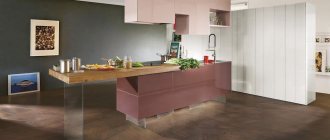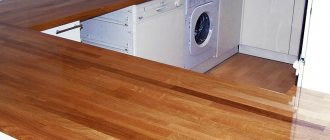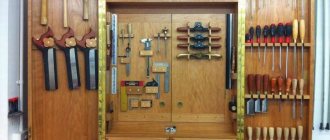- Empty the product from its contents. A wardrobe or bookcase already has a lot of mass, and things add extra weight to it. Also, during the rearrangement, something may fall out, this will complicate the already difficult work. When putting things away, arrange them so that they do not interfere with transportation in the future.
- Remove removable shelves, drawers and rods. Of course, there is no need to completely disassemble the entire structure; you just need to lighten it as much as possible.
- Secure the opening doors (otherwise they will interfere at the most crucial moment). You can use regular masking tape.
- Wash the floor thoroughly with any cleaning product - this will not only make moving a heavy cabinet easier, but will also reduce the risk of damage to the floor covering.
REFERENCE! It is contraindicated to move massive furniture in a room with a freshly painted floor - at least a week should pass for the surface to become strong enough.
After all the preparatory work, proceed to the main task. Some methods can make it much easier to move a heavy cabinet to the right place. The following will be a description of popular methods, just choose the best option for your case.
Using raw potatoes
One of the simplest folk recipes is the use of ordinary potatoes. The fresh root vegetable, which contains starch, provides slip and allows you to move heavy objects without causing damage to the floor. The cabinet can be moved using this method on the following floor coverings:
- laminate;
- linoleum;
- parquet;
- plank floor (only if there are no large gaps or differences between the elements).
To carry out the work, the tubers are thoroughly washed and cut into circles approximately 1 cm thick (the most common option) or cut in half.
ATTENTION! Potatoes need to be prepared immediately before use so that their surface does not have time to lose the moisture necessary for the furniture to slide.
To rearrange the cabinet, you need to slightly lift it and place potato pieces under the bottom. If the product is too massive, you should make more pads so that the cabinet does not simply crush them. Next, carefully move the structure to the desired location, remove the potatoes and wipe off any wet marks. Similarly, you can use lard skins by placing them at the corners of the cabinet. True, at the end you will have to thoroughly wash the parquet to remove any remaining greasy marks and specific aroma.
Using a wool rug
Another “old-fashioned” method is to move bulky furniture on a blanket or thick woolen rug (it is recommended to use old things so as not to worry too much about them during the process). By carefully spreading the fabric under the cabinet, you can move it without much effort, while protecting the parquet from scratches and the product from possible damage.
IMPORTANT! Rearranging using this method should be carried out by at least two people, so that one person pulls the rug, and the other person pushes the cabinet itself from behind. Otherwise, the backing may slip out, and you will have to lift heavy furniture once again.
Apply wax or soap
You can move a heavy object relatively easily using some available tools:
- laundry soap or soap solution;
- paraffin or wax.
Carefully rub the floor along the intended path of movement so that a visible layer of lubricant forms on the surface, ensuring sliding. After completing the work, everything can be easily washed with warm water.
ATTENTION! This method can only be used on smooth and hard floor coverings without any unevenness.
Furniture conveyor to help
Not long ago, a device appeared for heavy shelves and chests of drawers, which consists of a special jack for lifting furniture and small stands with wheels. Thanks to this invention, you can independently, without outside help, transport the cabinet to the desired location and at the same time:
- save time, nerves and health;
- do not scratch the floor and protect the piece of furniture from chipping;
- move furniture on any surface, including deep-pile carpet (to do this, you just need to choose a model with large wheels);
- save on the services of a loader - it’s easier to purchase a small set once and use it for a long time than to call a team each time and pay a lot of money, in addition, in many cities you can rent a transporter.
Children's furniture made of plywood: requirements, advantages and disadvantages, choice of material, manufacturing of parts, decoration, finishing and connections
How to easily move heavy furniture on carpet or rug
Let's start with the most difficult one, because... It is more difficult to move furniture on a fleecy surface than on smooth linoleum or laminate. There are both special devices and folk tips that will help you with this.
1. Furniture conveyor
This is a set of items that includes a small jack-lever, with which one of the corners of the furniture is raised, and four stands with independent wheels that can move in any direction. By placing mobile mechanisms under each side of the cabinet, you can easily roll it around the entire apartment. If you need to move furniture specifically over carpet, then choose a conveyor with wheels of a larger diameter so that they do not sink in the pile. Fortunately, there are many similar offers on the market now.
2. Special stands for furniture
They are small circles of different thicknesses and diameters. Smooth plastic ones are suitable for carpeting. They are attached either to an adhesive base, to screws, or to built-in nails. The last option is suitable for heavy furniture, because... turning it over and screwing the stand on is very problematic. By the way, the adhesive base may not support the weight of a massive cabinet, so it is better to strengthen it with super glue or something similar.
3.Garden/handcart
Particularly enterprising citizens use a metal cart with two wheels to rearrange furniture. This option is suitable if you want to transport a bedside table or small chest of drawers from room to room. However, if the furniture is quite wide, you may need the help of a friend to hold the opposite edge. Otherwise, you can get by with a belt or a piece of flat, wide elastic band to secure it.
4. Food foil
This simple thing will help you rearrange furniture on legs. This option is suitable for a table, couch, etc. A sheet of foil is folded in several layers, placed under the leg, and the free corners are wrapped around. This will prevent the material from moving to the side when moving along the pile. However, this method is not suitable for a very heavy cabinet - the foil will simply tear under its weight.
5. Polyethylene lids
This old-fashioned method is still popular because of its simplicity and accessibility. However, please note that it is only suitable for furniture with separate legs. If the edge of a sheet of chipboard is placed on such a stand, it will simply become deformed, and you will not achieve the desired effect.
6. Milk carton
This is exactly the case when they say: in a kulak economy, everything will do. If the furniture is not very heavy, then the bags can simply be put on the legs, but be sure to turn them inside out. The fact is that the inside of the package is treated with a paraffin-containing composition, which makes it easier to slide over the fleecy surface. To rearrange a massive object, the bag must be folded several times and only then placed under the corners.
7. A piece of fiberboard (hardboard) or old linoleum
A small chest of drawers or cabinet can be easily moved using hardboard or lenoleum, placing their smooth side on the carpet. But in order to move the resulting structure from its place, belts or ropes will be needed. Although, if the piece is large enough, you can simply pull it by one edge.
8. Wooden rolling pins for dough
The method is very exotic, but it has been tested for thousands of years. This is exactly how our ancestors launched ships into the water - by placing round logs under it. You will need three or four rolling pins, and you will need to rearrange them as you move. This option is optimal if you have an assistant who can quickly navigate. Then the process will not take much time.
Special stands
These are circles that vary in diameter and thickness. Plastic ones with a smooth surface are perfect for carpeting. On one side they may have an adhesive base or built-in nails. This is intended for fastening to the base of furniture. As practice shows, for heavy furniture you need to take circles with nails, since the adhesive base does not always withstand the load. You can do it simpler: strengthen the connection with superglue. You can tighten the screws, but it is very inconvenient and difficult.
Ways to move a cabinet
Anyone who has had to move heavy furniture without assistance knows that this requires skill and a lot of strength. To make the cabinet slide freely, you must first move it from its resting place. To do this, you should completely empty the wardrobe of things, removable shelves, and secure the doors. To carry out a quick, simple cleaning of the room, wash the floor with any detergent to obtain a clean, free surface.
Wild bee honey: what it looks like, beneficial properties and contraindications
Adhering to the simple laws of physics, the cabinet begins to move when the points of contact between the surface of the floor and the bottom of the furniture are minimal, the flooring is smooth, and the product is empty. Taking this into account, the sliding of an object along the base of the room increases significantly, without causing damage to the floor covering. You can speed up the movement of a heavy cabinet on a flat floor to the right place using simple improvised means.
Raw potatoes
The simplest and most affordable way to move a cabinet is the well-known and beloved potato. The raw root vegetable is perfect as a sliding substrate on floors covered with laminite, linoleum, or parquet. Potatoes, depending on the tactics used to move the cabinet, are cut in two ways:
- circles 5 - 7 mm thick;
- into two parts.
By distributing the chopped root vegetable under the bottom of the cabinet, where the halves are placed cut side down, it can be easily moved around the room. The starch contained in potatoes, without leaving scratches on the floor, is a good lubricant for sliding. Remaining traces of starch can be easily removed with a damp cloth.
Wool rug
To make moving furniture easier, use a thick wool or felt rug. Despite the fact that this method is considered effective and does not require much effort, the preparation process itself is considered labor-intensive. It will take at least two people to tilt the cabinet back and pull the fabric underneath the base.
By evenly distributing the fabric, you can quickly move the cabinet across parquet and laminate floors. With light hand efforts, you can successfully pull it across the threshold of the room, while protecting the floor from scratches and damage to furniture. In addition to the rug, you can use a camel blanket or wool blanket.
To overcome the threshold without damaging it, it is necessary to place on it a slab of lumber 18 mm thick, equal to the width of the opening and a length convenient for rolling.
Nylon covers
One of the most common household items found in any household will help reduce friction when moving furniture - plastic covers. Soft, flexible substrates lubricated with wax or soap easily fit under the base of furniture and ensure smooth sliding.
Slightly lift the heavy cabinet and place the required amount of lids under the bottom and move it around the room with minimal effort. This simple device is reliable and extremely safe for any type of floor covering. As an alternative, milk bags made of high-strength polyethylene film, characterized by a high degree of slip and strength, can be used.
Paraffin, wax and laundry soap
It is no less effective to move a piece of furniture using paraffin or wax, which are irreplaceable items in everyday life and reliable helpers in difficult situations. Products used as a lubricant form a thin, strong layer on the surface, ensuring easy gliding. All you need to do is rub the floor with paraffin, wax or laundry soap along the previously outlined lines of movement.
A prepared soap solution from laundry soap and applied to the surface will also allow you to quickly carry out the planned rearrangement. Products are removed from the surface using warm water.
Furniture conveyor
Today, to make it easier to move heavy pieces of furniture, a special device has been created that allows you to independently solve the problem of rearrangement without physical costs or the services of loaders. With the help of a furniture conveyor, which is easy to maneuver, even in the smallest rooms, you can:
- move an item to any location;
- protect walls, floors, cabinets from impacts and scratches;
- save time on rearrangement;
- move quickly on any floor covering;
- move furniture with maximum weight.
The operating principle of a home mover is simple. The hardened steel lever with rubber handle lifts cabinets of any size and weight. Transport platforms with rotating platforms on eight wheels are placed under each corner of the product. The furniture is transported silently, neatly and quickly to the planned location in the room.
Conveyor on rollers - how does this device work?
If you often have to move heavy furniture, then it makes sense to purchase a practical and convenient device – a furniture roller conveyor. It makes it possible to move cabinets, sofas and other heavy furniture without removing the contents from the inside, and adapts to any shapes and curves. The standard kit consists of a lifting arm and four platforms with rubberized backing and 360-degree rotating casters. The shape of the rollers may vary depending on the company. The companies POWERFIX and Bradex have proven themselves well on the Russian market. The build quality also affects the weight that the conveyor can support. The average load capacity is 100–150 kg.
The principle of using a roller conveyor:
- 1. Place the lever under the base and lift the corners of the furniture;
- 2. At each corner we place platforms (carts) with a round backing exactly in the center of the leg so that they do not slide off;
- 3. Roll the furniture to the desired location and remove the platforms, supporting the structure.
The main danger to your floor lies under the sofa: its legs or pull-out rollers can forever leave an indelible mark of their presence. Sensitive parquet and laminate flooring are especially affected, on which even small scratches and abrasions are visible. A sofa that does not scratch the floor will help to avoid the appearance of defects and maintain the beauty and integrity of the floor covering when unfolding.
It is easy to choose a sofa that does not scratch the floor: many modern models are equipped with convenient and safe mechanisms that allow you to avoid unpleasant consequences after unfolding. Let's look at the most popular of them.
Linoleum: material features
Before we talk directly about moving furniture on a material such as linoleum, you should understand what kind of material it is and why you should be careful when carrying large items over it. Despite the general unpretentiousness of this coating and its time-tested reliability, it is important to handle the material carefully so that its service life, declared by the manufacturer, ends prematurely.
Composition of linoleum
Linoleum is one of the popular floor coverings, which is produced in the form of rolls of various widths and is currently made most often on the basis of synthetic components. This material has a long history, if you go back to the very origins of its appearance. Initially, it was made on a fabric base, impregnated with ordinary vegetable oils - this format of the material dates back to the 19th century. In the 1950s, more modern types of coating were developed, which began to be produced on the basis of PVC.
Modern linoleum
On a note! At the beginning of the twentieth century, the largest producer of linoleum in the whole world was the Russian Empire. It lost its position after the October Revolution.
Now the largest manufacturer of linoleum is the Tarkett company, which has factories in Russia. But the building materials market offers products from other equally well-known brands. What their products have in common is the following - linoleum is produced in the form of large rolls with a width from 50 cm to 5 m, and the length of the canvas inside them is from 6 to 45 m. Moreover, the thickness of the material, depending on the class, varies between 1.5- 5 mm. There are also denser types of linoleum, their thickness is about 8-9 mm, but such options are rarely used for domestic purposes. They are usually used in warehouses and production facilities where the material is subject to significant stress.
Linoleum floor
In general, modern linoleum is not a homogeneous material; it consists of several layers:
- varnish top layer , which gives the coating shine;
- a protective layer that prevents damage to the color and texture of the material;
- decorative layer (often made of PVC), responsible for the appearance of the coating;
- fiberglass - the base, a kind of “spine” of the coating, providing tensile strength;
- base made of PVC;
- sometimes the last layer of material is fabric , which increases the heat and sound insulation properties of the coating.
Linoleum structure
The flexibility of linoleum and its elasticity, heat and sound insulation properties, and density will depend on the PVC layer. It can be called the basis of the material.
Basic properties of linoleum
Despite such a large number of layers, linoleum remains a fairly soft and elastic material, which is quite easy to cut, easy to install, but at the same time very durable, not afraid of moderate mechanical impact and does not wear out.
Laying linoleum
Methods for fleecy surfaces
To avoid tearing the soft covering, roller devices or sliding materials are used to move a large cabinet. Before you begin rearranging, the furniture must be prepared:
- completely empty the closet of things;
- remove removable elements (shelves, rods);
- secure the flaps with tape.
Furniture conveyor
The device consists of a lever for lifting furniture and four rotating platforms equipped with rollers. The tool set is sold as a set or rented. The lever is made of durable steel, so it can withstand any weight.
With this device, a person will be able to move the cabinet without assistance. It’s easy for even a girl to master. With the help of a home loader, the corners of the cabinet are lifted one by one with one hand, and the platforms are positioned with the other. Next, the furniture is silently transported to the desired location. The platforms are removed according to a similar principle.
Special furniture stands
They are represented by round parts made of smooth plastic of various diameters. Each element is attached to the cabinet with glue, screws or nails.
If you plan to use an adhesive base, it is recommended to secure the structure with a strong cyanoacrylate-based fixing compound. Rubber adhesive may not be able to withstand the load.
Garden type hand cart
Metal garden tools are suitable for transporting small bedside tables and chests of drawers. To transport larger items, you will need the help of a second person. You can transport a wide cabinet alone using belts or wide elastic bands holding the opposite edge.
Regular food foil
A fragile sheet of foil must be folded in several layers and placed under the legs. The remaining free edges are wrapped in a circle. This simple life hack will ensure reliable fixation of the material. The method is applicable only for light cabinets, since the foil will tear under heavy weight.
Nylon covers
A simple method used by no generation. Suitable for cabinets with built-in supports. If the lid is placed under a structure without legs, the edges will be deformed under the chipboard panel and the furniture will not move.
Packaged milk packaging
Used bags are suitable for moving light items. Before starting work, the packaging must be turned inside out. The inside of the bags is coated with a composition containing paraffin. With the help of milk cartons placed on the legs, the furniture glides easily over the carpet. For heavier structures, you will need to fold the packaging in several layers.
A piece of fiberboard (hardboard) or old linoleum
Lightweight pieces of furniture can be easily moved using hardboard scraps or leftover linoleum. You need to place the material under the corners with the smooth side facing down. If you have a large enough piece of material, you just need to pull the free edge to move it. If the fragments are small, you will need improvised means in the form of ropes, belts, and elastic bands.
Wooden rolling pins for dough
If you have an assistant, you can use three or four wooden rolling pins. This method has been used since ancient times, only then round logs were used. It is necessary to lift one edge of the furniture and place rolling pins. While moving, you need to move the released rolling pins again under the cabinet. With coordinated work, two people can complete the task in 2–3 minutes.
Preparation
Try to make your work as easy as possible by first disassembling and emptying the furniture that you will move.
It is advisable not only to remove all contents from the cabinet, but also to remove shelves, rods and other removable elements. Seal the doors with masking tape or tie something to prevent them from opening.
If you need to move a straight or corner sofa, then remove pillows and other items from it, take out bedding from linen drawers.
Prepare the means at hand that will make it easier for your feet to slide. Their choice depends on the type of flooring.
Difficulties in rearranging furniture on your own
Property owners often do not know how to easily move furniture in their own apartment. Carrying out work independently without experience can lead to negative consequences, the main of which are:
- Damage to structural elements such as legs and door handles.
- Deterioration in the appearance of interior items due to scratches on the facade or side surface.
- Potential risk of tearing linoleum or carpet, scratching laminate or parquet.
- Possibility of damaging the wallpaper on the walls, chipping the corners of doorways or scratching the jambs.
- The most unpleasant situation can arise if the owner of the apartment did not calculate his strength and was injured. It’s very easy to hurt your back when lifting weights.
In order to avoid such negative cases, there are a large number of ways. Compliance with safety precautions, the use of special professional tools or folk methods help to rearrange interior items, regardless of the floor covering and without outside help.
Consequences of careless handling
But linoleum, no matter how reliable and durable it is, needs careful care and careful operation. The above-described elasticity and some softness hide those features of the material that do not allow it to be handled roughly. When moving heavy things on linoleum, it is quite easy to damage it. Under the pressure of the cabinet legs, it bends, gathers like an accordion and, as a result, breaks. Repairing the material will be either difficult or completely impossible.
Damage to linoleum
On a note! Sometimes linoleum tears can be repaired using special cold welding, but this is an extra cost and extra work for the home owner. And the material cannot be restored to its 100% integrity. It is much easier to prevent damage to the coating if you move the furniture correctly.
Cold welding of linoleum - stages of work
By the way, even if the material is not affected by furniture constantly moving over it, it deteriorates under the pressure of the legs of a heavy cabinet or sofa. In places where there is large or massive furniture, grooves form on the material over time - the linoleum simply sinks under things. And even if you remove a heavy cabinet from it, the holes formed in the place of the legs will not always straighten out again - a lot will depend on the duration of the mechanical impact, as well as on the quality of the floor covering.
Torn linoleum
Tips and safety
To move furniture without problems and not get yourself into trouble, which could be worse than torn linoleum, you should listen to some advice and follow safety precautions.
- To begin with, immediately before moving furniture, it is better to free up space along the entire path of the cabinet. Otherwise, surrounding objects may interfere and even fall if a person walking with their back touches them.
- It is better to remove chandeliers if they have a hanging decorative form. Cabinets are usually quite tall and can damage the lighting fixture. As for rearranging the sofa or chest of drawers, this advice can be ignored.
It is better to remove a hanging chandelier first - If traditional methods are used, you need to move on the floor carefully - it is important not to slip or fall.
- It is better to empty the closet and other pieces of furniture where you can put something before moving.
- You can also secure cabinet doors to prevent them from opening during the process. This will prevent injury from a door suddenly opening.
- It is best to remove children and pets from the room where the change is taking place. There is a high risk of not being able to handle the cabinet and crushing someone.
It is better to remove children from the room where the rearrangement is taking place.
Video - How to move heavy furniture
It is better to move cabinets and other large furniture that can damage the linoleum together with someone. You can call friends or neighbors for help. It is better not to try to move it yourself, even using all the traditional methods. But light furniture can be moved independently. Let's hope the article will help you choose the most convenient method and easily rearrange your apartment!
Lubricant, glycerin, Fairy
All of the listed products have one similarity: they can be used to facilitate gliding on a smooth surface. Before use, dishwashing liquid must be diluted with water and foamed. But the lubricant and glycerin are used as is. To ensure that you do not damage the laminate or linoleum, you can take a piece of plastic, the same laminate, or other slippery material and place it under the furniture. If there is nothing similar, then a lid will do. package or packaging for dairy products, finally. The option is more designed for moving furniture within the room. Otherwise, you will have to wash off the greasy marks over a large area. And this will not be easy to do.
Precautionary measures
When moving bulky furniture, it is important to protect yourself from possible injuries, damage to the interior and the structure itself.
Here are some recommendations:
- You should not move furniture without auxiliary devices . This often leads to damage to floors and deformation of the cabinet, injuries to the back, arms and legs.
- Before work, you need to clear the room of unnecessary items . Otherwise, you may trip and injure yourself while working.
- During work, you need to monitor whether the devices have slipped out from under the base , and correct them if necessary.
- Make sure your position is stable . Do not rush, make sudden movements or forceful jerks.
Yes, you'll have to pay. But this option guarantees the safety of the interior, furniture and, most importantly, health.
During the renovation, we were faced with the need to regularly move furniture from place to place. At first, they did not attach any importance to this and, as a result, some of the linoleum had to be re-laid due to damage from the wardrobe. It turned out that there are many options for protecting floors and they all work. We used a wool rug option, which made moving the furniture easier and protected the new coverings.
Know-how in moving furniture from room to room
About 3 years ago I came across an interesting thing on Aliexpress. It's called a furniture conveyor. There was a good discount and I ordered it. 4 plates on rollers and a lift cost 650 rubles. I later saw exactly the same set in Leroy for 1,100 rubles. So the goods are not in short supply. But it costs differently everywhere.
The conveyor works like this:
- Using a lift, we raise the furniture to a height of approximately 2 cm (the height of the platform with rollers).
- We push the platforms further away so they don’t slip out.
- We lift the furniture on the opposite side and place it on the remaining platforms.
- Let's take it easy. The rollers rotate in different directions and travel well on carpet, tile, linoleum, and laminate.
Since the purchase, I have always used a conveyor when I need to move something from room to room. The platforms can support weights up to 100 kg. That's why I don't even pull out the contents. Recently I rolled a barrel at the dacha weighing 60 kg. Herself. And of course it’s better to have someone insure when lifting a tall cabinet or something like that. In addition, when transporting furniture, the platforms sometimes slip out. This needs to be monitored.
Let's summarize. It is possible to move furniture without scratching the floor. Even two fragile girls can cope with the task (tested from my own experience). You can resort to folk wisdom or purchase a special conveyor. Here everyone decides for himself.











